8 Must-Haves for Choosing the Perfect Bug Out Location
If a widespread SHTF occurrence ever takes place, the last place on Earth that you want to be is in a big city or some other densely-populated area. The emergency itself isn’t what should scare you the most, it’s the people living around you who will be especially dangerous and unpredictable following a disaster situation. Keep reading to discover what you need when choosing that perfect bug out location.
Grocery stores, restaurants, banks, and other buildings could be looted and burned, while bridges may even be closed or destroyed. There will be total chaos and complete mayhem in the streets. And before too long, they’ll start showing up at your door and your emergency stockpile will be all for naught.
Just so you know, I am not bugging out, most of you know this. I have everything I need right here to survive. But, I am aware some of you have a bug out location, or possibly someplace you can go if the SHTF.
Other Posts to Check Out
In case you missed them, here are some other bug out related posts to check out:
- 15 Reasons Why You Do Not Want To Bug Out
- Should You Bug In or Bug Out? What to Know
- How to Really Secure Your Bug Out Location
Must-Haves for Choosing the Perfect Bug-Out Location
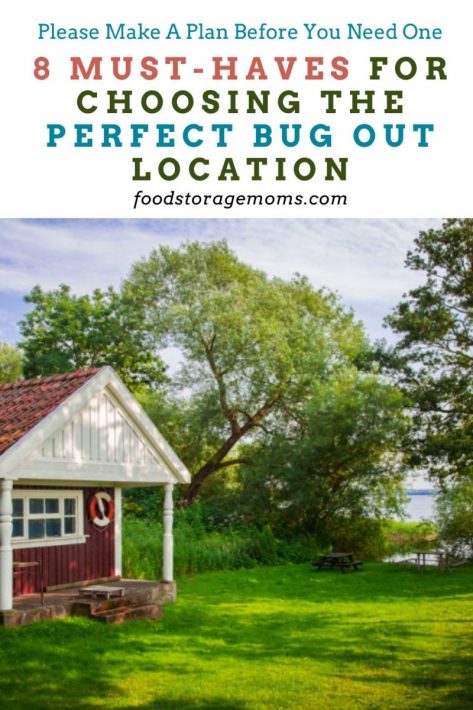
Even if you don’t live in a highly-populated area, your emergency situation may force you to evacuate the protection and comfort of your home. You’re going to need somewhere else to go to keep your family alive and safe. Do you have a back-up plan if things go from bad to worse in the middle of the night?
For those of you that are ready to take your prepping skills to the next level and are making preparations to get started with your bug-out location, there are a few important things that you need to consider first. Sure, surrounding yourself with natural resources and tracking down a secluded area is a place to start, but there’s much more to it than that. These are 8 must-haves when choosing the perfect bug-out location:
8 Must-Haves for Choosing the Perfect Bug Out Location
1. Distance
There needs to be a fair distance between you and any major city, but you also don’t want your location to be completely out of reach. Another thing to think about, is how are you planning to get to your location?
Will you be driving or will you set out on foot? When you’re traveling on foot, you’ll have to remember that you will be carrying your bug-out bag, so your journey probably should be no more than 60 miles away, depending on your physical condition and if you have others to take with you. If your plan is to drive, your location shouldn’t be further than one full tank of gas, unless you bring plenty of extra fuel with you.
2. Privacy
Seclusion is absolutely a must-have because you don’t want anyone to be aware of your presence there. There needs to be plenty of tree cover for privacy that will block out all of your lighting, whether it’s day or night.
When it comes to cooking your meals, it should be done during the night so that your campfire smoke is not as visible during the day, and so that people aren’t smelling what you’re cooking.
3. Secure Location
Not only is it important that you choose a bug out location that is secluded, but it needs natural security that comes with it too. This simply means that it should be harder for others to have access to your location. It needs to be further away from any trails or roads that could bring anyone in your direction.
Streams and other waterways close by are certainly convenient for your drinking purposes, but that could bring unwanted guests past your bug out location as well. Once you’ve decided upon a location, find out all of its strengths and weaknesses, that way you’re able to defend yourself or go on the offensive if you ever need to. You may need to set traps and tripwire alarms that will alert you when someone is nearby, depending on the severity of the situation you left.
4. Water Source
You simply don’t know how long you will have to remain in your bug out location and your supply of drinking water will only last for so long. That’s why you’ll want to track down a location that’s near a reliable water source, whether it’s a lake, river, stream, or a natural spring.
Keep in mind that you’ll also need it for cleaning, cooking, and watering crops and livestock if you have to stay for a longer period. You should also determine whether it will be accessible all year long.
5. Plenty of Resources
Eventually, your emergency rations and supplies will diminish and you’ll have no way of stockpiling back up by paying a visit to the grocery store. Your location will need plenty of resources so that you can maintain your self-sufficient way of living. These are just to name a few:
- Bountiful game and fishing nearby
- Plenty of surrounding area for sustainable gardening
- Resources and plenty of space for your livestock
- An abundance of firewood
6. Avoid Areas Prone to Natural Threats
When choosing the best bug-out location, potential natural disasters are another thing to keep in mind.
- You want to put as many miles between you and all of these possible threats, whether it’s a hurricane, tornado, wildfire, earthquake, or some other natural disaster. This may even require you to travel over a hundred miles from your home if you live along the coast where hurricanes are prone to strike.
- It’s also a good idea to choose a location that’s not subject to flooding from a lake, river, or stream so that if bad weather hits, your bug-out location isn’t swept away.
- For most of us across the country, it’s simply impossible to find a location that’s completely free of all-natural threats, but it’s still your responsibility to find an area that has as few as possible.
7. Plan Several Different Routes
Don’t just plan on taking the main roads to get to your bug out location following a disaster because they may be blocked off or utterly swamped with traffic. Be sure to come up with other backup routes ahead of time so that you can reach your bug out location safely, and hopefully not too far out of your way to get there.
8. Red Tape
Once you’ve purchased your bug out location property, that doesn’t mean you’re ready to break ground and start building. So, before you ever get to this point, make sure that you do all of your research ahead of time.
Find out if your bug-out location has zoning or government regulations that would infringe upon your bug out plans. You’ll probably be required to get a permit if you’re planning on altering the property by building on it.
8 Must-Haves for Choosing the Perfect Bug Out Location
Final Word
There are many things to think about when you’re planning your bug out location. Each and every single one of these will be crucial to increase the chances for your family’s survival. What are some must-haves for choosing the perfect bug out location that you’ve thought about or experienced? May God Bless this world, Linda.
Copyright Images: Bug Out To Summer Cottage by the Lake Deposit photos_89649610_s-2019

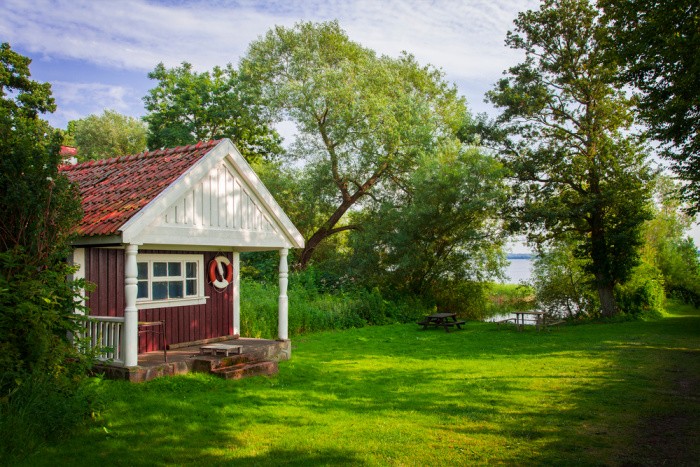

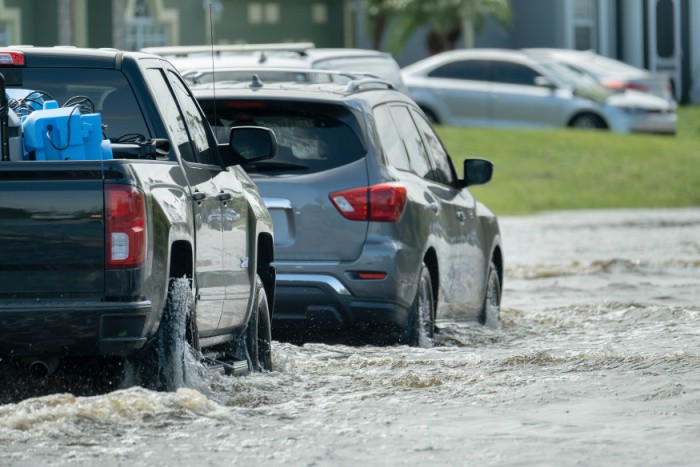

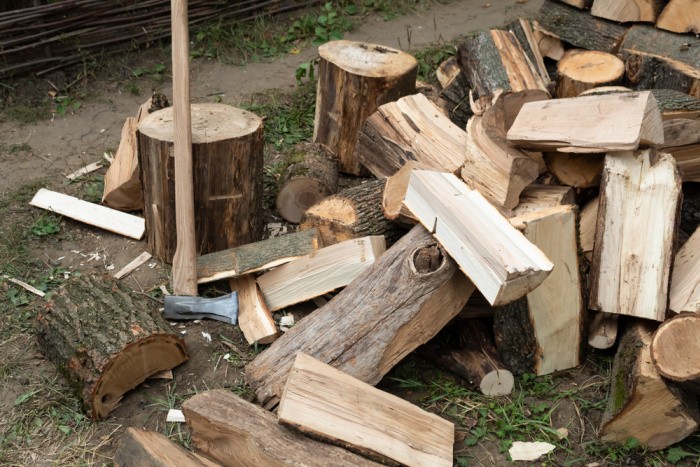

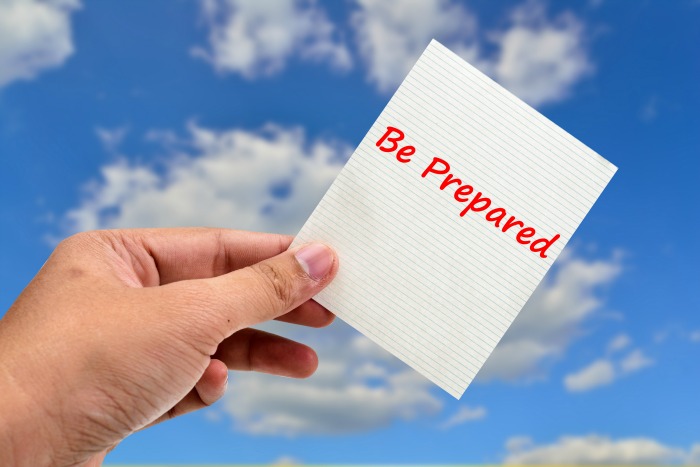















I’ve yet to find perfection though you’ve got a great list. There’s a reason these places aren’t populated and are secluded and it involves hardships.
What I’ve found is a place where I’m able to adapt to that hardship within my abilities as well as those who will be with me.
In other words don’t bug out to the side of a mountain if your spouse is in a wheelchair. Don’t try the frozen tundra on blood thinners and don’t look to haul water at distances with a bad back in the desert.
Be smart and stay safe.
Hi Matt, great comment, people really need to think before they bug out. I will not be bugging out. I wish I had a community of like-minded people where I live but I don’t. I really hope people think through the statement you made, we can only physically do what our family can do to bug out. Stay safe, my friend, Linda
Matt, I very much agree with your points. Over the years, I keep seeing these (mostly you tube) videos on ‘ bugging out’ but few take into account realities of doing such, like family members health, and other simply stark realities of starting over.
Thx
The reality is literally on our tv every night. Look at “refugees” going into say Europe. Mostly FAM fighting age males. Grandpa ain’t making the journey, mom and the 4 kids ain’t making it, no walkers, no one on insulin etc. Especially after cars/fuel/roads are out.
There are a few other political/religious reasons it’s just FAMs but you get the point.
Most folks are in trouble just hiking down the Grand Canyon or after 5 miles so just imagine a real march.
Matt, this is so true! Thank you! Linda
Matt, the older I’ve become, the more critically I look at young people’s health habits/overall physiques (let alone people my age of 60). Heck, I doubt even 5% could walk/bike/skateboard 10 miles away from home without giving up. I have 2 adult sons (ages 38 and 22), one grandson (age 20). I don’t worry about the 2 youngest but my 38 yr old? He’s skinny, has lost most of his muscle tone as he does little physical activity. Yet even he could probably make it home from a long distance. Yes, we live in what is a near perfect bug-out location. I look at online pictures of his childhood friends, and I doubt any of them could make it to my home roughly 40 miles away. And this is both male and female friends. Now, we are rural, right? My 2 youngest? They and their local friends are all physically fit. But, they have city friends and they are Not physically fit. I have a lodger in my home, age 27, who is easily 40 lbs overweight. Oh, he can still do physical chores (per our rental agreement) but frankly, I’d hate to count on him if shtf. As to your look at refugees…there’s a lot of Central Americans who have been traveling thousands of miles and women/children are a great portion of them. But, frankly, they aren’t overweight like our young people are! They are used to ‘Doing Without’ : while I whine because I haven’t eaten in a restaurant since March, and young people complain because bars/clubs just aren’t the same with all this social distancing. I’m not meaning this reply to be political in any way, but I’d take a group of migrant farmworkers over a group of young city folks any day if shtf.
HI Wendy, you nailed it. Linda
As always, you do an amazing summary of things to consider. Thank you for your site!
It is important to consider who owns the land you are looking at. I know quite a few people who say they will just go West and live on some farm land. A farmer might have something to say about that. Others say a National Forest. We have seen the government close National Parks and Forests in the last year.
Buying and hardening is difficult if you do not live there full time (unless you are family with the people nearby). Hunters love “abandoned” cabins and people nearby will know if you have built one….I think the days of Bugging out are limited. Someone else will probably be in the cabin when you arrive.
I am with you and will be bugging in. Be in a moderately small town anywhere, but in or near the 10 most populous cities in the country, and you will, probably be fine bugging in.
Hi Janette, fabulous comment! I totally agree with you. Can you imagine that cabin you built that was supposed to be your bug out cabin??? Only to find squatters? They will not give up that cabin easily. I agree with you on the National Parks, they have been closing them in Utah as well. The ones I feel bad for are the ones living in the most unsafe cities in America. I pray for them daily. God help us. Linda
If we could afford a bug-out location it would be our bug-in location. As in our place of residence. Not where we live now. I don’t know if there are any like minded people here in NE Utah. Anyway, just have to make do with what we have. As usual, great info Linda!
Hi Karl, I like your idea. If we could afford a bug-out location it would be our bug-in location!!! I LOVE LOVE LOVE this! I live in Southern Utah, no like-minded people in my neighborhood. Thanks for your kind words. Stay well, stay safe. Linda
I once read that a fairly safe place is on the third road. (nothing will be 100% safe) . Even more would be better.
1. The main road, highway, freeway, where there is fast travel, cities, towns and lots of opportunity.
2. The secondary, the one off the highway, fewer residential, farms. A bit more space.
3. Then the third one off that, the one that just looks more isolated less traffic with fewer people and more distance between homes. Easier to protect. Desperate people will be looking for quick supplies and lots of opportunity. Isolation is not the best for the unprepared or the unskilled and unprepared. Too many unknowns.
I never dreamed I would see our nation go downhill so fast. Socialism of all things. Time to prepare if you haven’t started. Time to get serious about it. Read, study, prepare.
Hi Mary, I never really thought about the third road. Thank you for sharing, this totally makes sense. I totally agree with you about desperate people will be looking for a quick everything! Isolation has never made sense to me. Now, those that are trained and skilled yes (former military) I’m thinking could do it and enjoy it, maybe. I never thought our country would be in such a mess. I just shake my head and think “who did you vote for”??? I have never asked that question ever until this year. Let me re-phrase that, I was shocked to see who people I knew were proud to shout out who they voted for on social media. Yikes! I unfollowed them immediately. I did not unfriend them only unfollowed. Did they not realize who they were voting for? There are no words. God Bless our Country. Linda
Mary in mn: I’m in rural minnesota and you are very correct about the third road. I only live 40 some miles from mpls but people get lost trying to find my place, even with gps. Lol, old-time paper maps? Even worse! Lots of the ideas in Linda’s article about having different routes are very good too. My kids used to walk/bike/skateboard to our neighboring towns. They know a lot of shortcuts/roads less traveled. Um, my family from the twin cities would have an awful time…
I’m more than double that from the cities. Almost all hunters on our road. I feel quite safe. Not to far to town not too close. Moved here about 6 yrs ago. Love the quiet and i don’t mind a bit of isolation. Best thing we did. We were way to close to mpls, 20 miles, before the move. Did not feel safe at all. So we are preparing a place for the family to escape to when needed. Our friends thought we were crazy to move, too old. We are retired. I’m thinking better late than too late.
Hi Linda, I recommend people seek out property off the tertiary or even smaller roads. That they break a rough temporary access to it to bring in everything they need to get setup (Building supplies, furniture, stash, household needs, etc). I recommend they pre build enough housing for everyone coming, a barn, chicken coop with a large run, rabbit hutch with a run, and a proper pig keeping shed with an outdoor run and water, decide where their crop growing areas, fruit bushes, vines, and orchards will be, plus pasturage for goats, sheep, and donkeys will be, include some undisturbed meadowland, then heavily, fence their compound with 5-6 ft high chain link and razor wire. I suggest sturdy guard dogs, (not attack dogs, guard dogs) for sounding an alarm when anyone, or predator animals approach, and herding dogs to care for and protect stock. I also recommend they drill 2 artesian wells using wind power with hand powered back up. This will be safer water for humans and stock to drink, as surface water may be contaminated early. It takes much longer for contamination to reach artesian levels and hopefully it will remain low. I recommend they seek out like minded people with vital skills or willingness to learn them. No one person can learn everything they will need, so they should divide and conquer, then employ an apprentice system to pass skills down. Along with a resource library and that continuing to teach the essentials, (reading, writing, math, basic sciences, history, and record keeping skills). I recommend an attached greenhouse to grow vital greens, vegetables, and citrus, for a varied diet, hot and cold frames, underground refrigeration and freezing, underground hidden storage for their stash of essentials, and passive solar to power important things like hot water and laundry equipment, out houses for sanitary use, away from crop lands. I recommend getting together a group, several families and singles, for genetic and social reasons, as well as self defense. I don’t encourage martial attitudes! But encourage Passive protections and being able to use firearms if needed. I recommend hunting, fishing, trapping, and snares, to supplement meat supplies. I suggest using bramble berries as additional protection along fence lines. (Plus they add to the harvest for jams, jellies, and preserves. I recommend keeping a wood lot, planting nut trees, training grapes up apple trees, and other resources that are not super visible to inexperienced eyes. I recommend foraging, for wild herbs, greens, roots, and mushrooms, with guards for protection from predator animals and marauding humans, natural herb craft and emergency medicine. Growing and making textiles, knitting, crochet, weaving, rug making, spinning of plant fibers like linen and cotton, and animal fibers, (sheep, goats, donkeys, shed dog and cat fur, fur removed from skins, feathers and down, and leather crafting. I firmly suggest they learn as many vitally important skills before needing them, through on line, book study, and classes, ( way to meet like minded people and recruiting. Build that resource library to the maximum, including references and patterns for every kind of skill and science, books and materials for home schooling, arts and crafts, reading materials for every age group, religion and civil government forms. Anthropology, sociology, history, the making of every need for survival from Cookbooks and sewing, to making candles and soap, small engine repair and maintenance, repair and maintenance of water, wind, solar, and any other mechanical need possible. A fully trained blacksmith and smithy can machine parts and repair or make new plows and other metal gardening and farming equipment from stockpiled and recycled metals, with a good reference library. They need references on maintaining and using a wood lot wisely, plus carpentry and woodworking skills. Building and maintenance of small electrical skills. References for safety and safe foraging, recognizing poisonous snakes ( they will no longer be rare after SHTF, predatory animals will increase as well. They will need human and veterinary references for health issues, references on foraging plants and their uses, natural healing, and all the resources they need. Cider making, distilling, and fermenting, sanitation virtually everything they need to create a small thriving, multigenerational settlement. Pregnancy, childbirth, child health and safety, elder care, and elder healthcare, maintaining health of all ages will be essential. I encourage being prepared to them maximum, to survive and thrive completely on their own, and being able to defend themselves, when they have too. I do not save tips or encourage militarism, raiding or warfare of any kind. I encourage self reliance and being able to defend themselves. After the January 6 Nightmare, everyone should be able to see what facing the rabble after SHTF! There were both professional seditionists and warmongers, and misled people led into violence and terrorist behaviors that day! There were some very terrible things planned for that invasion! While the Capitol Police may be faulted for poor readiness, when push came to shove, they responded outstandingly! While they could not stop the invasion, they slowed it enough that those in danger were led to safe rooms, and none were captured or killed. Even the ballots were secured and removed! It’s an example of what anger can lead people to do. Add in trauma, thirst, hunger, and fear, that is what our Preppers turned Survivors will have to face and guard against. They may also face militant bands, and survivalists who would take everything and possibly rape, torture, and kill them for the takeover of their compound. So they need to be ready to defend themselves. Unfortunately gentle pacifists won’t survive. Eventually they may be able to trade with other compounds, and I encourage them to be prepared for that. Isolation away from cities and towns, with everything they need to survive is the best of a number of ways to survive. I am elderly and in poor health, I won’t survive a SHTF event for long. But I’m farm bred, with plenty of experience in being prepared for isolation. I grew up in the 60’s, the Cold War years, I remember the Cuban Missile Crisis well. I was taught how to make or access for a Fallout shelter in 5th grade. I’ve hunted and fished, I’m woods wise, and stock wise. I’m experienced in preserving every type of food in about every way possible. I advise against cows and horses because they are huge eaters and require finer grazing and supplemental grains. I advise goats, sheep, and donkeys, as they can survive and thrive on rougher pasture and browse. They are tougher health wise and survive in a wide range of conditions. They can fulfill all the same roles as cows and horses. Plus their fur can be used for fabric. My Pinterest site is extensive and I keep growing it with more information as I find it. I recommend heating and cooking with wood, and building an outdoor kitchen for hot season use. I also recommend a large screened tent for use as an outdoor activity, eating, and sleeping area. Mosquito proof, rain protection, cooler than a building built for safety and winter warmth. A safe shaded place for elderlies to get air and small children to play with supervision and safety. That’s my vision. I agree with all your points, and concur with the comment about choosing a place to bug out that takes in your entire group situation. All elderlies, infirm, exceptional needs, and pets must be brought to the safe Haven. That is the final purpose of a rough access road. Once everyone is in, it must be hidden and sown over with fast growing trees, bushes, black willow, hazel, low bush and high bush blueberries, blackberry brambles, even transplant in some poison Ivy, oak or sumac if necessary, other wild plants, barberry brambles, and everything that is naturally present in the surrounding land. Larger rocks should be scattered over it to make it impossible to use, and less likely to spot. Using wild plants and naturally escaped plants can be useful to harvest and attract birds as natural alarms. Open areas can be sown with Hardy grasses and a mix of wildflowers appropriate for your region. These are passive defense strategies. Bugging out isn’t a vacation, it is permanent, considering nearly all the forms SHTF can take. You prepare your site in advance, have some of the group move in and maintain it, while preparing the land and starting to grow gardens and crops. Once everyone arrives, you shut the door behind you permanently. Burn your houses you formerly lived in if necessary to leave no clues, although exercising excessive care, should make that a real last resort. Leave some food in cabinets and fridge, a few dishes and pans in the cabinets, made up beds and some clothes in the closets, towels and soap in the bathrooms, etc. Leave it looking like you’ve gone out to forage and are planning to return. Lock the doors. You should watch for being followed, just for safety. When vehicles arrive, they can be drained of gas to use up in chain saws and others temporary uses, stripped of useful parts, and buried where they can be dug up later and melted down. That’s the way I see it Linda. When you bug out, you start all over with a new life. Everything possible, ready in advance. God Bless our planet, and all living beings. MA
Hi MaryAnn, wow, wow, wow! I LOVE LOVE LOVE your comment! Talk about comprehensive, you are amazing! What is your Pinterest name? Thank you so much! Linda
Hi Linda, Thanks for the thumbs up, I try to cater to Preppers of all levels, from those just considering the idea of preparing for the worst, to those who are trying to figure out where to start, and even experienced Preppers, by saving ideas and possibilities they might not have thought of. For example, they don’t need to return to the early Colonial days, solar and wind technology can pump water from wells, and provide some use of electric power. Limited mechanical technology is within their grasp. Modern washers would be useless, but the older wringer on top models would serve well. There are still plenty around and some can be purchased for parts, until they can machine their own parts. Tanned leather can be used for belts and the electrical components are very basic. My Father kept one going for years! Every time her modern machines broke down or wore out, he brought it in from the barn and we washed the clothes in it. They have far more capacity, than any of the modern off grid designs I have seen. The use of food processors during canning season would save a lot of hand prep time. Real irons would be much easier than sad irons, I have used those, they are difficult, but an iron is needed to sanitize bandages, before wrapping, even if they’ve been boiled. Treadle machines can be used for sewing and repairs, but basic older model electrics would be faster. Just for small things like that, having a limited solar array would make life easier. A basic hot water system for example, for kitchen and bathing, is a heck of an improvement on washtub bathing and heating water on the stove for dishes and cleaning, (or bathing). I’ve heated water that way myself and it’s heavy work! They can easily install a grey water cistern system for reusing the water in their gardens, in a pinch it could be clarified and distilled for drinking water. That’s another of my proposals, keep what technology is possibly. A simple lighting system in the barn is 110% safer than lamps or candles. Any with Asthma or severe allergies could still use inhalation machines, even with only water or homemade saline they will work, it just takes longer. I save everything I can see as useful, even if it seems unusual. My Pinterest name is the same
MaryAnn Coy. The Board is called Homesteaders/Preppers, because that is how I see them. Prepping is vital, but creating a secluded Homestead with a group of like minded, multiple skilled, multi generational people is how they will survive. Most SHTF scenarios are pretty permanent, or will take so long to recover from, ( as in a Cascadia Event, or a New Madrid Earthquake) they are better off taking their future in their own hands, and starting over with a new lifestyle. If anything on my site interests you for an article, I’d be happy to help dig up more information. MA
I feel fortunate to live in the San Juan islands in the Pacific Northwest….plenty of game/fish and that 20 mile water moat between us and the mainland in nice. Greenhouse and garden and plenty of stocked up pantry’s.
Hi Jabber Joe, wow, that sounds wonderful. You are prepared for sure. You can catch a fish and cook it for dinner! Then make a veggies side dish or salad from your garden. Life is good!! Linda
How are you fixed for the Cascadia Fault, and its inevitable rupture? Do you have a plan? It would be good for someone from that area to talk about prepping for that kind of disaster.
Hi MaryAnn, I live on the Wasatch Fault line. Let’s see if someone lives near the Cascadia Fault, thank you! Linda
If Jabber Joe lives on the San Juan Islands, he will be close enough to be within the disaster ground zero. They are offshore of Washington State (part of WA. state) and British Columbia nearly on top of the Cascadia Subduction Zone (Pacific Plate is diving under the Northern North American landmass). The fault is 20-25 miles off the coast. Maximum damage and major Tsunamis. Geological evidence has shown extremely high Tsunamis poured miles inland and oral history among the local Amer-Indians confirms it. Areas of swampy marsh along the coast do indicate the coastline sank. Hawaiian folklore mentions large Tsunamis hit the North Coast of the Islands. Japan also had airou Tsunami event after the last Subduction event. As did Alaska. The reason I mentioned it and New Madrid was because both faults are way overdue for a strike slip shallow quake and both have a history of 9.2+ level ruptures. Both also will cause extensive catastrophic destruction. New Madrid has the potential to cause severe to extreme damage from the Gulf shore, to Chicago! It will take years to recover, maybe decades.
Hi MaryAnn, great comment. I can’t even imagine the damage from a 9.2+ level earthquake! My fear is losing our 3 U.S. power grids. It would take decades to recover as well. Great information, thank you! Linda
Linda, like you, I’ll be bugging in, but if I decide to purchase a bug out location I’d be tempted by Southern Missouri or Northern Arkansas. Parts of Tennessee could make the cut too. Lots more humidity and bugs than I’m used too here in AZ but good land, even waterfront land is relatively affordable, wild game is abundant and the climate is good for gardening. And if you’re really lucky some of the properties may even have live caves (best storm shelters/root cellars imaginable).
Hi Ray, oh my gosh, now we’re talking about land that I would love! The caves, interesting thought! You rock! Linda
Linda, when I was kid I had an uncle who owned a small farm in SW MO. On that farm was a live cave that Jesse and Frank James (distant relatives) played in as children. They’d carved their initials into a wall. My uncle had boarded up the entrance and used the cave as a root cellar. Perfect temp and humidity. He stored veggies like carrots and potatoes in beds of clean sand. Some canned goods were stored on shelves he’d built. There was a gas lantern for light. My brother and I thought it was the coolest place ever!
Hi Ray, wow, what a great story!! I can almost visualize it!! If you think about it, he was very smart to plan that out! I love it! Linda